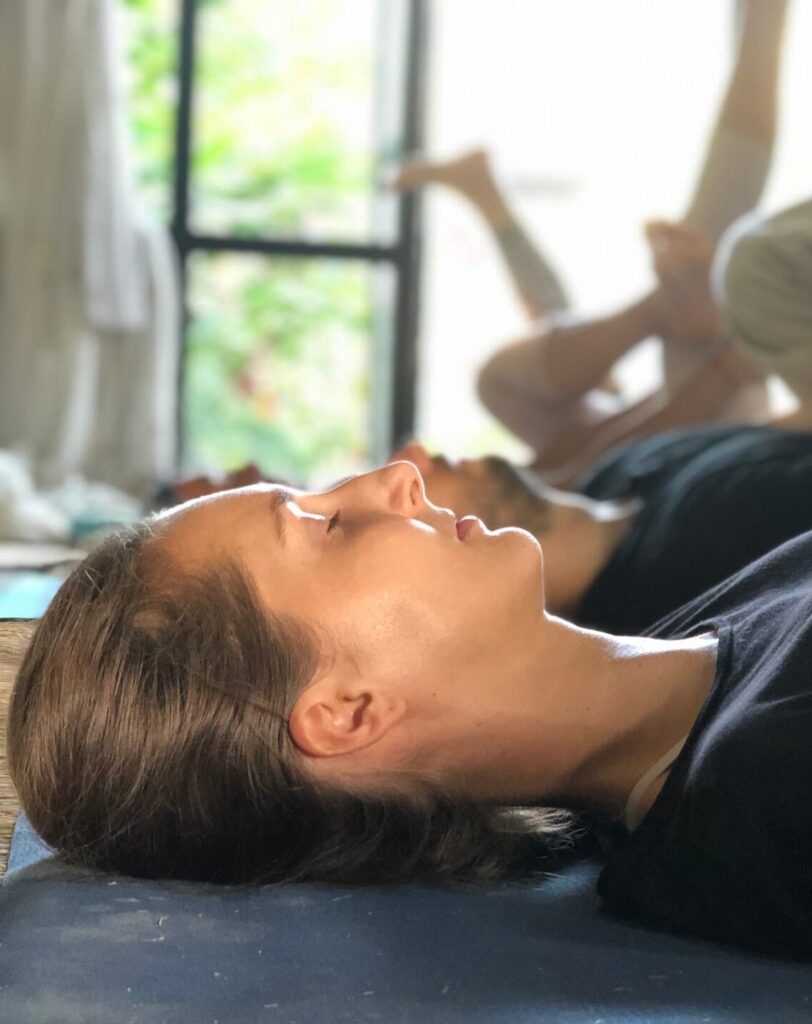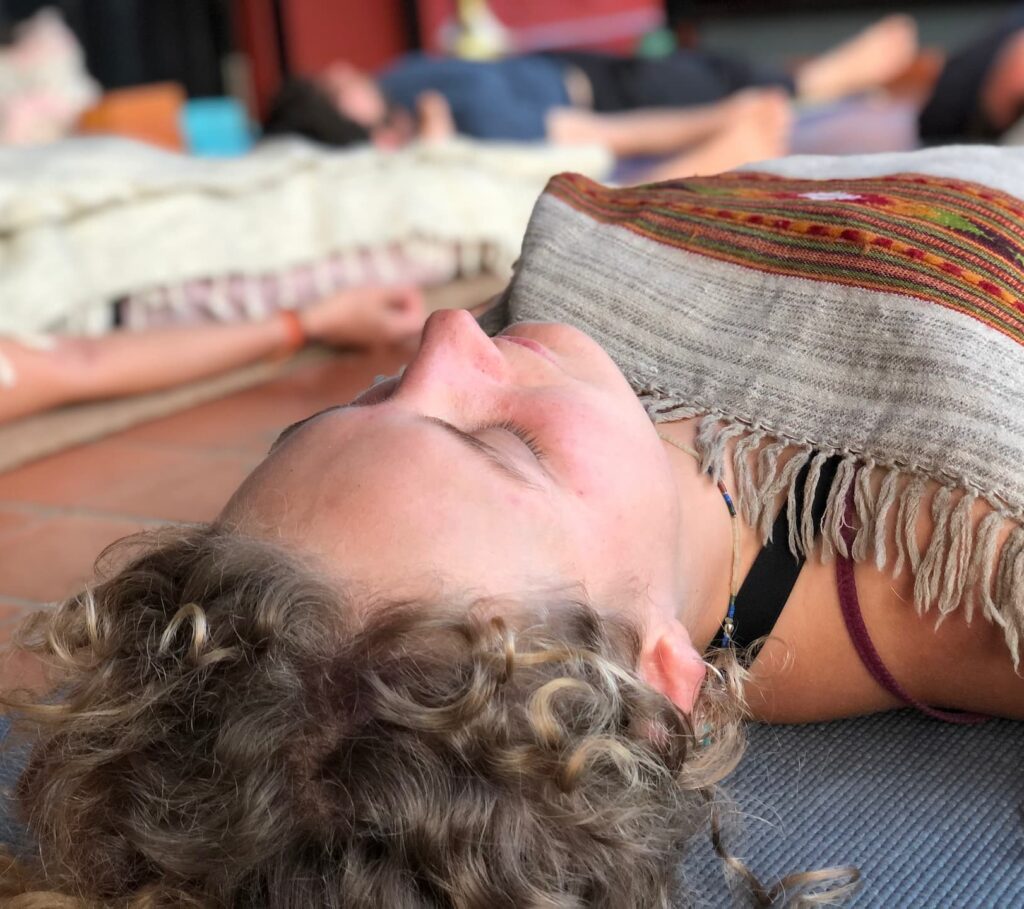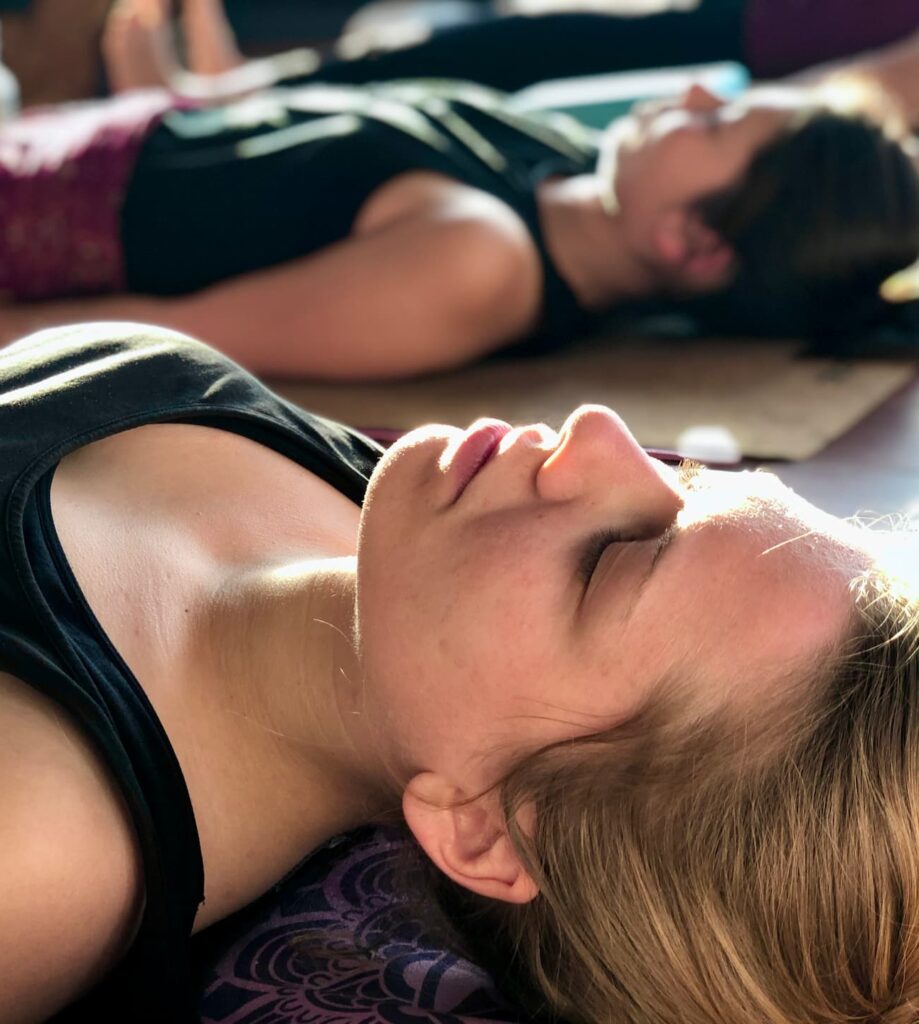In recent times, the Yoga Nidra teacher training course has gained immense popularity. Today people are always connected, accessible and deeply stressed. The mind gets dispersed and we scatter our energy over different topics. Because of that our nervous system is constantly under pressure as our minds are filled with many thoughts at any given time. Yoga Nidra is an effective and efficient way to activate the parasympathetic part of our autonomous nervous system. As a result, deep recuperation and healing happen. This training is designed for both dedicated teachers and sincere seekers who wish to experience Yoga Nidra not just as a relaxation method, but as a profound journey into expanded awareness.
Yoga Nidra is referred to as the “Yogic sleep”. This is a state of being between sleep and awake in full consciousness. In contrast to our normal sleep or awake states, this is immensely favorable to deep emotional and physical healing. A brain mapping study found that Yoga Nidra practitioners’ brains show that they are in a deep resting state, which is seen in deep sleep while being completely conscious. In those states self-healing processes are initiated, trauma and emotional as well as physical stress can subside.
Yoga nidra benefits are immense. At Vedic Yoga Academy, you will learn Yoga Nidra as a spiritual practice to help release old burdens and find your own strength. As you spend more time inside your mind you will learn to align your conscious mind with your powerful subconsciousness. Therapeutic applications of Yoga Nidra are used by doctors and healers in our modern world. With the increasing cases of Insomnia, sleep deprivation and emotional suppression, Yoga Nidra has become the most important practice. Yoga Nidra said to work with:
100 Hour Yoga Nidra Certification Course:
for those who want to understand the basics principles of Yoga Nidra and teach it to others.
Details:
Course Length: 2 weeks
Location: India and Nepal
Cost: $800 – $980
200 Hour Yoga Nidra Teacher Training:
for those who want to go deep into the higher levels of consciousness and explore it in great length as Sadhana.
Details:
Course Length: 4 weeks
Location: India and Nepal
Cost: $1050 – $1300
85 Hour Online Yoga Nidra Training:
for the students who want to learn and benefit from Yoga Nidra practice. Likewise, you will learn how to guide and teach. We teach rare ancient Yoga Nidra techniques from Himalayan tradition and offer online Yoga Nidra teacher training as well.
Details:
Course Length: 7 weekends
Format: Online Weekend training
Cost: $600 – $800
If you are struggling with stress, anxiety, or burnout, try this course out. Anyone with a sincere interest in inner awareness, and healing can join the course as well. You don’t need to be an advanced yogi or experienced teacher to begin. This training welcomes those who want to explore the power of Yoga Nidra for their personal growth.
Whether you’re a yoga teacher, wellness coach, therapist, or simply someone curious about the mind-body connection. All you need is an open heart, a willingness to learn.
After you finish the training, you’ll be ready to teach Yoga Nidra. You’ll get a Nidra teacher certificate from Vedic yoga academy, which means you can teach anywhere in the world. You can run your own retreats, teach at studios, or even offer classes online.
Yoga Nidra has become a real game changer in my life. I started it after having a panic attack 2 years ago. And here I am now with a complete reset of my daily life. The course was great I can definitely recommend it. I wish I would have joined a longer programme.
-Maya, Germany
It is a practice, which one should learn in the presence of an experienced teacher. Maintaining silence within and having an open and safe environment to practice Yoga Nidra, is required. Immersive Yoga Nidra training retreat on location can provide all the necessary tools for practice and guidance.
In the end, choose the style that matches your goal, whether that’s personal healing, relaxation, or learning to guide others.
Before starting Yoga Nidra teacher training, think about why you want to do it. Do you want to relax and heal yourself? Or do you want to help others find peace and rest through Yoga Nidra?
Knowing your reason will help you choose the right course and get the most from your training.
What’s the deeper purpose of Yoga Nidra beyond just relaxation? Why do people commit to teaching it?
Yoga Nidra is often described as guided relaxation, but its roots are much deeper. It’s a pathway to pratyahara, turning awareness inward and eventually to meditation itself. When you train to teach, you’re not just helping people rest; you’re guiding them into expanded awareness, healing, and transformation. Many students commit to teaching because they want to share this doorway to freedom with others.
How is training in Yoga Nidra at a traditional school in India, different from learning it online or in the West?
Online or Western trainings often focus on scripts and techniques. At Vedic Yoga Academy, we teach Yoga Nidra in its original context, connected to yogic philosophy, pranayama, mantra, and meditation. You live the practice daily, surrounded by teachers who embody it. This immersion gives depth and authenticity that cannot be replicated in a short online course.
Can Yoga Nidra be used to support trauma healing, and do you train teachers in how to hold space for that?
Yes, Yoga Nidra can be profoundly healing for those carrying trauma. But it must be guided with sensitivity. In our training, we teach how to create safe, nurturing sessions, adapt the practice for different needs, and recognize when referral to professional therapy may be more appropriate. Holding space responsibly is a vital part of becoming a Yoga Nidra teacher.
Will I learn how to create my own Yoga Nidra scripts, or do I just repeat the traditional ones?
You’ll study traditional structures and learn why each stage exists. But more importantly, we teach you how to design your own scripts with creativity and sensitivity. By the end, you’ll be confident to guide sessions for beginners, advanced practitioners, children, or specific groups, without relying only on pre-written scripts.
How does Yoga Nidra connect with the Eight Limbs of Yoga, like pratyahara, dharana, and dhyana?
Yoga Nidra is a bridge practice. In the Eight Limbs, pratyahara (withdrawal of senses) comes before concentration and meditation. Yoga Nidra gently leads the mind inward, step by step. With training, you’ll see how it integrates seamlessly into the yogic path offering access to stillness, clarity, and insight that arise in meditation.
Is Yoga Nidra safe for everyone? Are there cases where it should be adapted?
For most people, Yoga Nidra is safe and deeply restorative. But in cases of severe trauma, PTSD, or certain mental health conditions, extra care is needed. In training, we cover how to adapt language, pacing, and structure to meet different needs, ensuring your guidance is safe, supportive, and inclusive.
How can I integrate Yoga Nidra with my existing role as a yoga teacher, therapist, or coach?
Yoga Nidra fits beautifully alongside many paths. Yoga teachers use it to close classes or retreats. Therapists bring it into sessions for stress and trauma recovery. Coaches and healers use it for clarity, creativity, and goal-setting through sankalpa. Our training helps you adapt Yoga Nidra into whatever work you’re already offering.
What kind of personal transformation should I expect during Yoga Nidra Teacher Training?
Yoga Nidra is not just something you teach, it’s something you live. During training, you’ll experience deep rest, emotional release, and clarity about your own inner journey. Many students describe it as a reset for body, mind, and spirit. This transformation becomes the foundation of your teaching, giving you authenticity and presence.
What is the role of sankalpa in Yoga Nidra, and how do I guide others in creating one?
Sankalpa is a heart-centered intention, planted in the stillness of Yoga Nidra. It’s not about wishful thinking, it’s about aligning with your deeper truth. In training, we teach how to create sankalpas that are clear, authentic, and powerful. You’ll also learn how to guide others in finding intentions that resonate with their soul.
How does the training prepare me for real-life challenges like students falling asleep, becoming emotional, or struggling with silence?
These things happen often, and they’re part of the learning. We train you in practical skills: how to adjust tone and pacing if students drift off, how to hold compassionate space if emotions arise, and how to guide people gently into silence without fear. These real-life tools make you a confident and grounded teacher.


